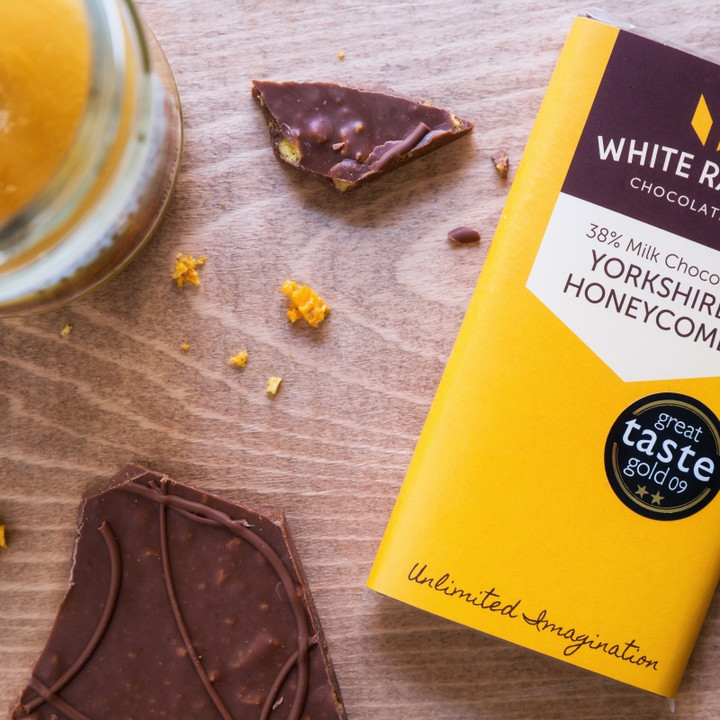There’s an old saying about getting what you pay for.
The trouble is that, in the modern world, too often others also get what we pay for – or don’t, as the case may be.
This is definitely true of chocolate, where its origins define both the quality of its flavour and how good or not you can feel about yourself when you take a bite.
At White Rabbit Chocolatiers, we are absolutely passionate about these roots, and have gone to great lengths to select a supplier and grade of produce to use in our signature creations and grocery supplies, which is second-to-none.
Many people who visit our shop and café will be very familiar with the colourful array of chocolate designs that fill the space on all sides.
However, not everyone will have noticed the less ostentatiously wrapped ‘couvertures’ stacked neatly on one shelf.
Yet these are the basis for all the magic that takes place here at White Rabbit Chocolatiers, and the ethos we live and create by.
What is couverture?
This is the high quality base ingredient produced by the chocolate industry, and supplied for use in everything from chocolate making to baking.
These nuggets of base chocolate are what we blend with other, secret ingredients, to create our signature White Rabbit novelties, bars and bakery. We sell them in their basic form too, because they are perfectly delicious to eat on their own for enjoyment or even medicinal purposes (more on the latter in future blogs), or our customers can buy them to use in their own homemade baking and making, with fabulous-tasting results.
We stock between 10 and 12 different types of couverture at any one time and constantly vary our selection, to give our customers the opportunity to try something new. We know they are as excited about chocolate as we are, which is why we constantly keep an eye out for exciting new finds, like the new Vietnamese couverture launched recently, called Vietoi which exhibits hints of citrus, wood and tobacco flavours.
We source our couvertures from great companies such as Valrhona, the world-renowned French chocolate house where our Master Chocolatier Sally Hawkes trained in her art. This brand is synonymous with the best possible quality and standards, which result from the way the beans are grown, right through to the traditional process used to manufacture the end product. We then select which individual couvertures to sell, based on taste.
Valrhona is a standard bearer in the chocolate world, rigorously controlling and overseeing every stage of the growing and processing its cacao (the formal term for cocoa), making sure best practice skills and know-how are applied throughout all their processes. This guarantees their range of couvertures have consistently great flavours.
Sweet heartache
Chocolate is a valuable commodity, like gold. As a result, producing it can be a very lucrative and ruthless business, and many of the environments where it is grown are very volatile, geographically, politically and economically. The growers themselves work extremely hard to produce the cocoa beans, and are often rewarded with low pay and poor conditions, tempting them to give up and go to the cities in search of a better life.
We never buy chocolate from countries where the business is not regulated and responsibly controlled.
“By contrast, we choose the extra fine quality of couverture from trusted companies because of the way the beans are grown, monitored, harvested and processed, developing the farmers’ skills to produce a higher quality product at a higher price and hence a more sustainable life for them and their families." said Sally.
“Valrhona process their chocolate in a completely unadulterated way, holding onto the pure cocoa butter, whereas a lot of other companies remove it and replace it with cheaper ingredients like vegetable oil or, worse still, palm oil. Ironically, more cocoa butter goes into making cosmetics these days, than goes into most chocolate.”
She added: “There are basically two ways of buying chocolate – as raw beans or as couverture.
“Valrhona, and other companies like Casa Luker in Colombia and Robert in Madagascar, have their own chocolate estates and growers, and they look after their employees. They work in partnership with cooperatives of farmers, paying them a fair price for their produce, helping to build important infrastructure like schools and supporting the development of farming skills, to help ensure the quality of the chocolate producing industry they rely on for their livelihoods survives.
“This ethical approach is also vital when it comes to maintaining consistency in the way their chocolate tastes. As a result, it is used in some of the best restaurants in the world, and by some of its most renowned chefs.”
An artisan industry
The process of manufacturing the couverture is a work of art in itself, according to Sally.
“Valrhona bring all the beans they harvest in pockets of the world from Africa to the Caribbean islands and various South American countries, back to their single factory in Burgundy – which was established in the 1920s and hasn’t changed a great deal since. There, it is tested and tasted, and prepared for sale," she said.
“The beans are processed into couverture chocolate on old-fashioned copper machinery, and the couverture is tasted constantly as it is manufactured, to ensure it is of the finest quality. This commitment to taste is THE key ingredient of fine chocolate.”
And it is this true chocolate taste too many of us have lost touch with in today’s, largely mass-produced world, Sally believes.
“The sheer volumes of chocolate we consume in the West can have a negative impact on the communities the ingredients are sourced from, as they struggle to cope with that demand, and the prices the mass market is prepared to pay to meet it.”
In reality, what we have come to recognise is chocolate– the mass produced bars and boxes created by a number of household names to satisfy this burgeoning demand – is a pale imitation of how wonderful this foodstuff can and should really be, according to Sally.
“The couvertures we use as the base ingredients in our chocolate making are special and in short supply, hence they command a higher price. As the old saying goes… you get what you pay for. They have a high cocoa content - some as much as 100 per cent, whereas many of the popular brands contain 20 per cent or less,” she added.
Did you know?
Like fine wine, chocolate is characterised by a variety of different ‘flavour notes’, depending on the place and conditions in which the beans are grown. It can have hints such as citrus, nuttiness, spice, smoke, tobacco, earth, honey and vanilla, to name a few.
Below is a list of the couvertures we currently have in stock, and their variety of flavours,
Manjari – 64%, Madagascan origin chocolate, with ‘bursts of citrus and red fruits’
Tumaco – 65%, Colombian origin chocolate, with a deep chocolatey, fruity finish
Caraibe – 66%, Caribbean origin chocolate with soft nut and coffee hints
Nyangbo – 68%, Ghanaian origin chocolate with warm, soft and spicy notes
Guanaja – 70%, West Indian origin chocolate, bitter, complex and aromatic
Vietoi – 73%, Vietnamese origin chocolate with citrus, wood and tobacco undertones
Santander – 85%, Colombian origin chocolate with a deep, woody, vanilla and fruity flavour
Abinao – 85%, African origin chocolate with a distinctive, tannic bitterness
Ecuadorian – 71% Ecuadorian origin chocolate with tastes of flowers and dried fruits
Venezuelan – 43% Venezualan origin chocolate with essences of roasted cocoa, hazelnut and butter
La Republica – 31% Dominican Republic origin un-deodorised white chocolate
Caramelia – 36% milk chocolate with a creamy caramel flavour
Azelia – 35% milk chocolate with a chocolatey and hazelnut character.
Our chocolate novelties and bars are made from a blend of the above origins, with other secret ingredients, to produce our own signature chocolate flavours, designed to suit a wide variety of tastes. We spend a lot of time experimenting to find the right mix of origins with other ingredients, to create award-winning flavours that people will really love.
If this article has, literally, whetted your appetite to discover more about ‘true’ chocolate and its qualities, why not pop in and sample a variety for yourself, and see if you can taste the unique flavours? You'll receive a very warm welcome!
Try our recipe for raspberry shortbreads with Tainori cream.




